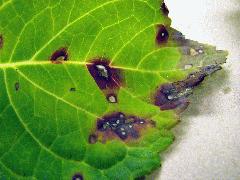Source(s): Holly Thornton
There are many fungal leaf spot pathogens that affect a very wide range of host plants. One very common leaf spot on hydrangea is Cercospora leaf spot caused by the fungal pathogen, Cercospora hydrangeae.
This fungal leaf spot can affect most hydrangeas and is generally an aesthetic issue for homeowners. The pathogen will rarely kill the plant but can reduce plant vigor by defoliation. It is generally more problematic in low maintenance landscape situations or when homeowners overhead irrigate their plants.
Depending on the type of hydrangea (oakleaf, bigleaf, etc.), the leaf spot symptoms may vary. Spotting generally begins at the base of the plant on older leaves and works its’ way up the plant. The spots are generally small, circular, and scattered across the leaf surface. They tend to have tan centers and dark brown or purple borders (see images). The leaf spots can oftentimes be irregular or angular shaped.
Verifying the presence of this particular fungal pathogen is very straightforward.
- Place the leaf under the dissecting scope;
- Look for the presence of tiny black structures within the tan/black/purple leaf spots;
- Using your scalpel, pick several of those tiny black structures and place on a prepared microscope slide (place a small droplet of water or acid fuchsin on the center of the slide);
- Place a coverslip over the droplet;
- Using the compound microscope, search for spores of the fungal pathogen (see below).
Cercospora sp. conidia generally vary in size, but are usually hyaline (clear) elongated (filiform) and several- celled. The conidia are borne on dark, clustered conidiophores that appear to burst out of the leaf spots. Below are drawings of the fungal conidia from the Illustrated Genera of Imperfect Fungi (4th edition).
Once the presence of this fungal disease is verified, it is important to stress to the homeowner the following about the survival and management of this fungal pathogen:
- The fungus survives in fallen diseased leaves that remain on the ground. Therefore, sanitation to remove the dying and diseased leaves will help prevent subsequent infections or outbreaks.
- The conidia of the fungus are spread by splashing water. This can be from rain, which is impossible to control, or from overhead irrigation. It is important to minimize the amount of leaf wetness. If at all possible, install soaker hoses or drip irrigation to prevent water-splash on the leaves. If your lawn irrigation system just barely hits the hydrangeas, then, yes, this will be problematic and can create an environment that supports the reproduction and growth of this fungal pathogen. Late summer rains can also perpetuate this disease.
- In severe cases, as previously mentioned, defoliation can occur, which reduces vigor and growth of the plant.
- Fungicide applications are rarely warranted due to the fact that the symptoms usually do not appear until late summer. Protectant fungicides are available for homeowners who just have to spray something or for severe cases of this fungal leaf spot. They include (listed by active ingredient): Chlorothalonil, Myclobutanil, Mancozeb, and Thiophanate-methyl. Begin spraying when spotting is first seen and follow the label for repeat applications (usually every 10-14 days).
References
- Illustrated Genera of Imperfect Fungi. 4th edition. Barnett and Hunter.
- Diseases of Hydrangea. ACES Publication. ANR-1212. 2001.
Resource(s): Common Landscape Diseases In Georgia
Center Publication Number: 269
- Cercospora Leaf Spot on Hydrangea - September 22, 2013
